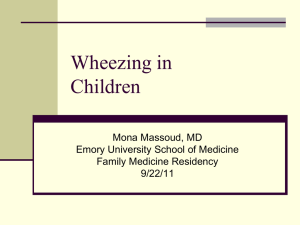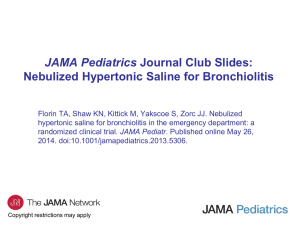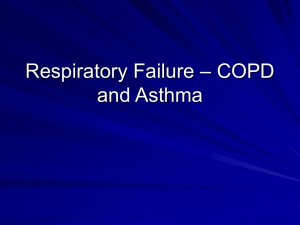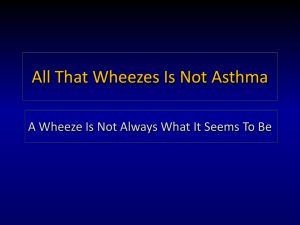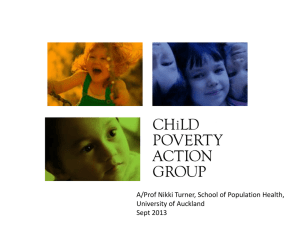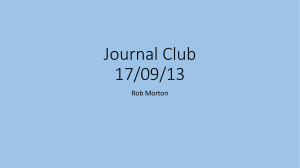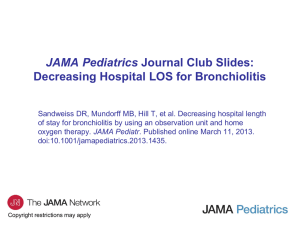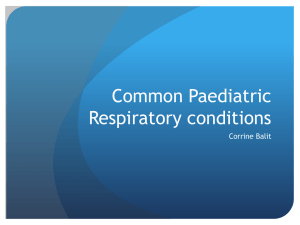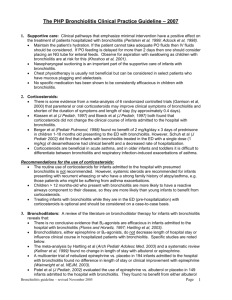The Wheezing Child - Croydon Health Services NHS Trust
advertisement
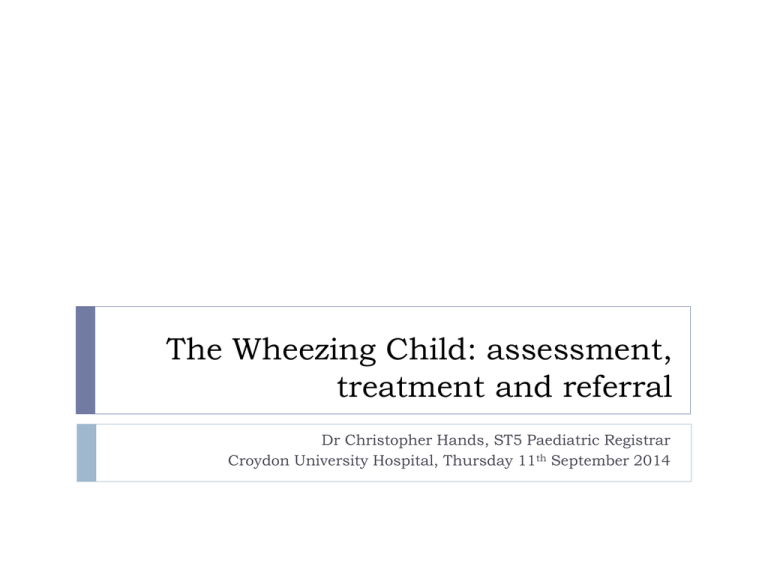
The Wheezing Child: assessment, treatment and referral Dr Christopher Hands, ST5 Paediatric Registrar Croydon University Hospital, Thursday 11th September 2014 The Wheezing Child Why this talk: Common paediatric presenting problem End point of variety of pathological processes Large burden of disease Frequent diagnostic uncertainty Wide variations in management amongst paediatricians and primary care physicians The Wheezing Child (2) Presentations: Bronchiolitis Asthma Virus-induced wheeze Pneumonia Chronic cough Presentations Guidelines Guidelines on which this talk is based: SIGN (2006), Bronchiolitis in children SIGN/BTS (2012), British guideline on the management of asthma BTS (2011) Guidelines for the management of community acquired pneumonia in children Bronchiolitis Virtually all infants are infected by RSV by the age of three years, around 40% to 50% develop involvement of the lower respiratory tract and 2% to 3% develop severe disease leading to hospitalisation Pre-existing anatomical and immunological abnormalities related to maternal smoking in pregnancy in particular may mean that an RSV infection presents as severe bronchiolitis, rather than a mild respiratory illness Airway oedema and mucus plugging are the predominant pathological features in infants with acute viral bronchiolitis Fig 1 Epidemiology of respiratory syncytial virus infection. Bush A , and Thomson A H BMJ 2007;335:1037-1041 ©2007 by British Medical Journal Publishing Group Bronchiolitis (2) Factors which predispose to acute bronchiolitis • Otherwise normal babies admitted to hospital for acute bronchiolitis have evidence of airflow obstruction before their bronchiolitic illness and this is still present at age 11 years • Evidence exists of abnormality of immune function in umbilical cord blood in babies of mothers who smoke during pregnancy and these babies subsequently develop RSV infection; the relation of these changes to RSV bronchiolitis has yet to be worked out in detail • In preterm babies who have airflow obstruction as a consequence of prematurity and of its treatment, a lesser degree of airway inflammation than usual can cause serious respiratory compromise Bronchiolitis (3) Absolute indications for hospital referral for acute bronchiolitis • Cyanosis or really severe respiratory distress (respiratory rate >70 breaths/min, nasal flaring and/or grunting, severe chest wall recession) • Marked lethargy leading to poor feeding • Respiratory distress preventing feeding (<50% of usual intake in past 24 hours) • Apnoeic episodes • Diagnostic uncertainty (toxic infant, temperature ≥40 degrees centigrade) Bronchiolitis (4) Relative indications for hospital referral for acute bronchiolitis Peak severity of illness day 3 – day 4 • Congenital heart disease • Any survivor of extreme prematurity • Any pre-existing lung disease or immunodeficiency • Down's syndrome: these babies have a degree of pulmonary hypoplasia and may also have potential or actual upper airway obstruction • Social factors: isolated family (concerns about the ability of the family to notice any deterioration) Bronchiolitis (5) Treatment: No evidence for efficacy of bronchodilators or steroids; both can have important adverse effects In hospital, nebulised hypertonic saline reduces length of stay SIGN guideline is evidence-based NICE guidance expected April 2015 Post-bronchiolitis symptoms Cough and wheeze may last several weeks after bronchiolitis (post-bronchiolitic syndrome) Intermittent symptoms may continue for several years No study has shown that inhaled steroids are effective Wheezing exacerbations may respond to standard bronchodilator therapy Post-bronchiolitis symptoms (2) The relation between RSV infection and subsequent asthma is hotly debated However, pre-existing atopy may be a marker for more severe bronchiolitis, and atopy itself predisposes to asthma Asthma VIW/asthma most common paediatric ED presentation Major cause of morbidity and hospital admission, especially in winter months Preventative medication commonly under-used 1.1 million children in the UK have asthma – 1 in 11 (Asthma UK) BTS guidance for 5-12 year olds BTS guidance for under 5 year olds Indications for specialist referral in children Virus-induced wheeze Between one quarter and one half of all pre-school children have symptoms of wheeze with a respiratory infection Most do not go on to develop asthma Under-5s with episodic wheeze but without interval symptoms do not have asthma-type airway inflammation, and are not helped by steroids Episodes of wheeze and a history of atopy are strongly predictive of those who will develop asthma Paediatric pneumonia In a 2001-2 study, the incidence of childhood communityacquired pneumonia was found to be 14.4/10,000 for 016 year-olds, and 33.8/10,000 for children less than five years old Between 2006 and 2008, admission rates for childhood CAP declined by 19%, after the introduction of the conjugate pneumococcal vaccine (PCV7) S pneumoniae is still the most common cause of childhood CAP Viruses cause 1/3-2/3 of cases of CAP Mycoplasma is an important cause of CAP in school aged children Paediatric pneumonia (2) Bacterial pneumonia should be considered in children when there is persistent or repetitive fever >38.5 degrees together with chest recession and a raised respiratory rate Children with signs and symptoms of pneumonia who are not admitted to hospital should not have a chest x-ray All children with a clear clinical diagnosis of pneumonia should receive antibiotics as bacterial and viral pneumonia cannot reliably be distinguished from each other. Paediatric pneumonia (3) Children aged <2 years presenting with mild symptoms of lower respiratory tract infection do not usually have pneumonia and need not be treated with antibiotics but should be reviewed if symptoms persist Amoxicillin is recommended as first choice for oral antibiotic therapy in all children because it is effective against the majority of pathogens which cause CAP in this group, is well tolerated and cheap. Paediatric pneumonia (4) Questions Case 1 5 year-old boy 5th child of 7 in Somali family living in 2 bedroom house in Norbury Mother reports that he has been coughing ‘off and on’ for the last six months On direct questioning she says she thinks it’s worse at night Vitamin D deficiency, takes Abidec; no allergies Imms up to date up to one year; has not had pre-school booster Born in Somalia at term; came to UK one year ago Case 1: Examination Active, bright and alert, thin Allergic nasal crease Harrison’s sulci No respiratory distress Slightly prolonged expiratory phase; faint end-expiratory wheeze throughout PEFR 80% of predicted Examination otherwise unremarkable Case 1: Questions Does this child need further investigations? What treatment would you initiate? Case 2 8 month-old Hungarian girl Has been coughing for the last two days with a runny nose Mother brought her to the surgery today because she ‘seems to be having difficulty catching her breath’ Doesn’t want to drink as much milk as normal, but is eating her normal finger foods and rice Born in the UK at 36 weeks by caesarian section; stayed in hospital for five days because of jaundice No medical problems, Health Start vitamins, immunisations up-to-date No family history of atopy Case 2: Examination Active, alert, coughing Smiling and playful Normal posture and movements Heart rate 130, normal heart sounds, no murmurs Capillary refill time 1.5 seconds Temperature 37.8 degrees Respiratory rate 55; moderate subcostal recession and some intercostal recession Showers of fine crackles throughout the lung fields; polyphonic wheeze throughout (Oxygen saturations 97%) Case 2: Questions Does this child need further investigations? What treatment would you initiate? Case 3 3 year-old girl Has been unwell with a temperature and a cough since yesterday; doesn’t seem to be improving Mother has noticed that her daughter is having difficulty breathing Has been eating and drinking ok, still passing urine regularly Born at term; hospital admission for bronchiolitis at four months, otherwise has been well. No medications; immunisations up-to-date Case 3: Examination Alert, watchful and miserable Clinging to her mother Temperature 38.5, heart rate 140, capillary refill time one second Respiratory rate 40; moderate subcostal recession Oxygen saturations 95% Reduced air entry and fine expiratory crackles at the right base Case 3: Questions Does this child need further investigations? What treatment would you initiate? Case 4 2 year-old Ghanaian boy Developed runny nose and cough last night (both elder brothers unwell with colds) This lunchtime started to have difficulty breathing and his mother can hear wheezing Born at term in the UK, normally well Has eczema, normally managed with emollients; has had two courses of topical steroids in the last six months Has never had wheeze before Immunisations up-to-date Both brothers have hayfever; mother has hayfever and eczema Case 4: Examination Alert, happy, breathless Temperature 37.9 degrees Respiratory rate 60; oxygen saturations 93% Good air entry throughout; widespread harsh wheeze Heart rate 120; capillary refill time 2 seconds Given salbutamol 100 micrograms ten puffs via spacer in the surgery Following therapy: Respiratory rate 35; oxygen saturations 98%; minimal wheeze Heart rate 150 Case 4: Questions Does this child need further assessment in the emergency department? What treatment would you initiate? Is there a role for oral steroids in this child’s treatment? Case 5 8 week-old boy, seen with mother and two elder sisters, aged 3 years and 5 years Started coughing this afternoon; now seems to have some difficulty in breathing Mother thought he felt hot; measured his temperature as 37.6 at home Born at 35 weeks by emergency caesarian section because of antepartum haemorrhage Mother smoked throughout pregnancy Birthweight 1.8kg; current weight 2.9kg Has been well since birth Mother is a single parent and has two further children at home, aged 7 and 10 years; all her other children are currently well Case 5: Examination Active, alert, smiling Normal posture and movements Temperature 38 degrees HR 140; capillary refill time 1 second Oxygen saturations 98% RR 50; mild-moderate subcostal recession Prolonged expiratory phase Good air entry throughout; scattered crackles and faint wheeze throughout Case 5: Questions What is the likely course of this child’s illness? Does this child need further assessment in the emergency department? What treatment would you initiate? Case 6 5 year-old boy Became unwell with cough and fever yesterday morning Today has had increasing difficulty in breathing and his chest hurts Born at term; no postnatal problems Used to have a salbutamol inhaler for intermittent episodes of wheezing, but it was lost a few months ago No other medical problems; no medications No family history of atopy Not immunised as his parents ‘don’t believe in it’ Case 6: examination Alert, miserable, coughing Temperature 38.5 degrees (paracetamol 2 hours ago) Respiratory rate 40; oxygen saturations 95% Does not cooperate with peak flow measurement Prolonged expiratory phase; moderate subcostal recession Minimal air entry left lower zone; widespread wheeze; resonant to percussion throughout Given ten puffs of salbutamol inhaler via spacer: Oxygen saturations 95%; minimal air entry left lower zone; respiratory rate 40; no wheeze Case 6: Questions Does this child need further investigations? What treatment would you initiate? Does this child need any ongoing therapy? Case 7 9 month-old Zambian girl (corrected gestational age) Cough and gradually worsening difficulty in breathing since yesterday Only child; both mother and father have colds Two previous hospital admissions with breathing difficulties, and has been assessed on several other occasions in the emergency department Stage 3 retinopathy of prematurity; treated with laser Takes Abidec and Sytron Born in the UK at 27 weeks’ gestation Stayed in NICU for 8 weeks; discharged home in air Case 7: examination Alert, smiling Wriggling and trying to escape from mother’s lap Temperature 38 degrees HR 120; capillary refill time one second Oxygen saturations 97% Respiratory rate 45; moderate subcostal recession Good air entry throughout; polyphonic wheeze heard throughout Trial of inhaled salbutamol: no difference to wheeze or respiratory rate Case 7: Questions Does this child need further assessment in the emergency department? What treatment would you initiate? What is the diagnosis? Questions Summary Points Wheeze is caused by different pathophysiological processes Age of the child aids differentiation of disease process Bronchiolitis: supportive care only Most infants with bronchiolitis don’t need hospital admission Most children under 2 with mild-moderate symptoms don’t have pneumonia Most pre-school children with wheeze don’t have asthma Many asthma admissions are provoked by poor preventer use/lost salbutamol inhaler References 1. Bush A, Thomson A, ‘Acute Bronchiolitis’ British Medical Journal 2007;335:1037 2. British Thoracic Society Community Acquired Pneumonia in Children Group, 'Guidelines for the management of community acquired pneumonia in children: update 2011', Thorax 66: Supplement 2 3. Frank PI et al, ‘Long term prognosis in preschool children with wheeze: longitudinal postal questionnaire study 1993-2004’, British Medical Journal 2008;336:1423-6 References (2) 4. Maclennan C et al, ‘Airway inflammation in asymptomatic children with episodic wheeze’, Pediatric Pulmonology 2006; 41(6):577-83 5. Panickar J et al, 'Oral prednisolone for preschool children with acute virus-induced wheezing' New England Journal of Medicine 2009; 360:329-338 6. Scottish Intercollegiate Guidelines Network (2006), 'Bronchiolitis in children’ 7. Scottish Intercollegiate Guidelines Network and the British Thoracic Society (2012), ‘British guideline on the management of asthma’

